MITS5505: Knowledge Management Case Study and Implementation
VerifiedAdded on 2022/10/31
|8
|2513
|198
Homework Assignment
AI Summary
This assignment addresses key concepts in knowledge management through a case study analysis. It begins with a brainstorming session focused on increasing employee perception of personal worth within a global company, utilizing nominal group techniques and consensus decision-making to identify effective non-monetary reward strategies. The assignment then explores knowledge codification, defining general frames for objects like horses, students, and pilots, and applying these frames to describe specific examples. Furthermore, it evaluates two approaches to knowledge development, concluding that a generalist with strong interpersonal skills paired with a knowledge developer is more effective. Finally, the assignment examines the failure of knowledge management implementation in a global company, analyzing the breakdown across five distinct stages, highlighting issues in advocacy, strategy development, initiative design, expansion, and institutionalization. The assignment provides comprehensive solutions and insights into various aspects of knowledge management and its practical applications.
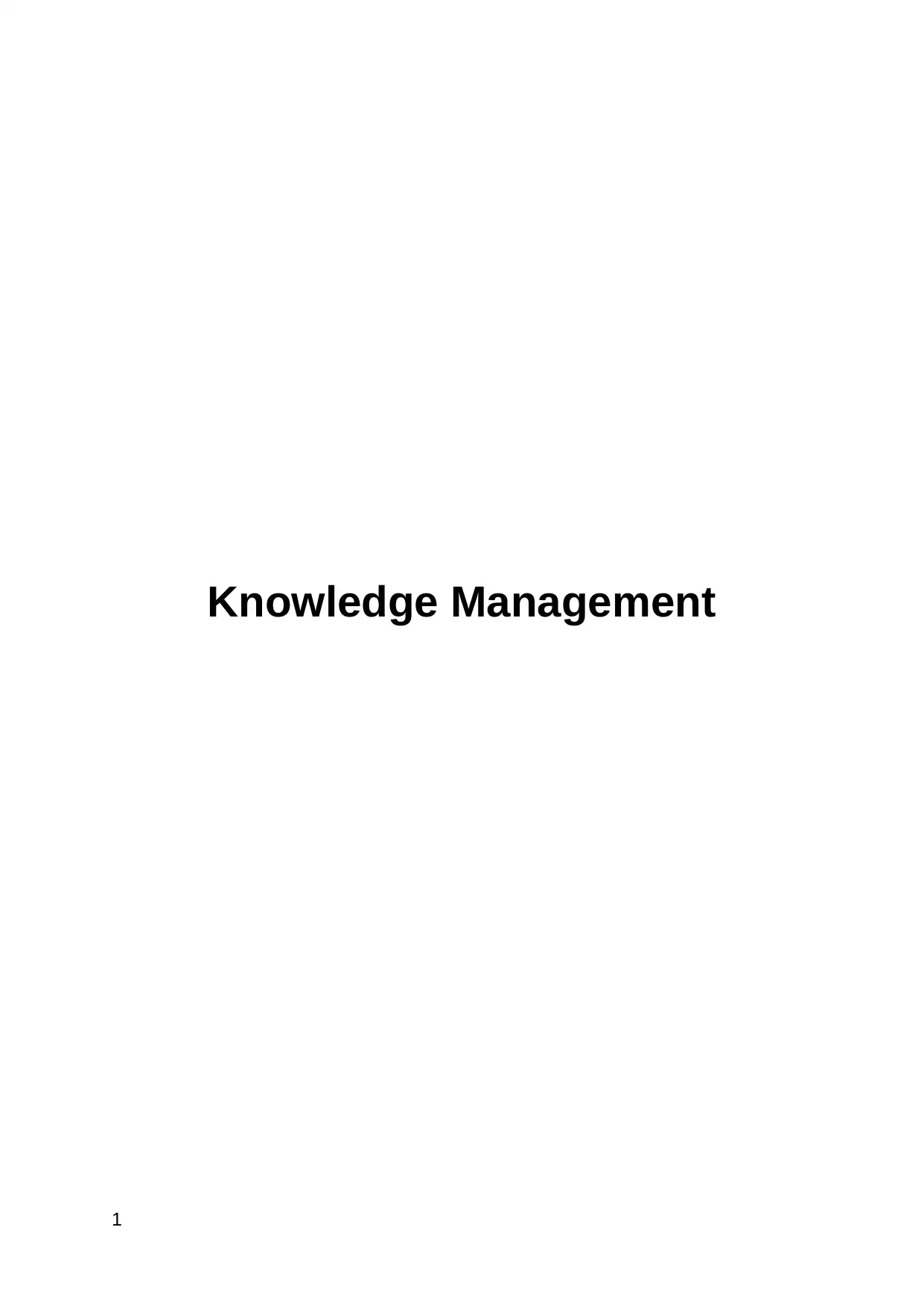
Knowledge Management
1
1
Paraphrase This Document
Need a fresh take? Get an instant paraphrase of this document with our AI Paraphraser

Contents
4.2 Brainstorming..........................................................................................................3
5.1 General Frames of Knowledge management........................................................4
5.2 Knowledge development........................................................................................5
7.1 Failure of knowledge management implementation...............................................6
References...................................................................................................................8
2
4.2 Brainstorming..........................................................................................................3
5.1 General Frames of Knowledge management........................................................4
5.2 Knowledge development........................................................................................5
7.1 Failure of knowledge management implementation...............................................6
References...................................................................................................................8
2
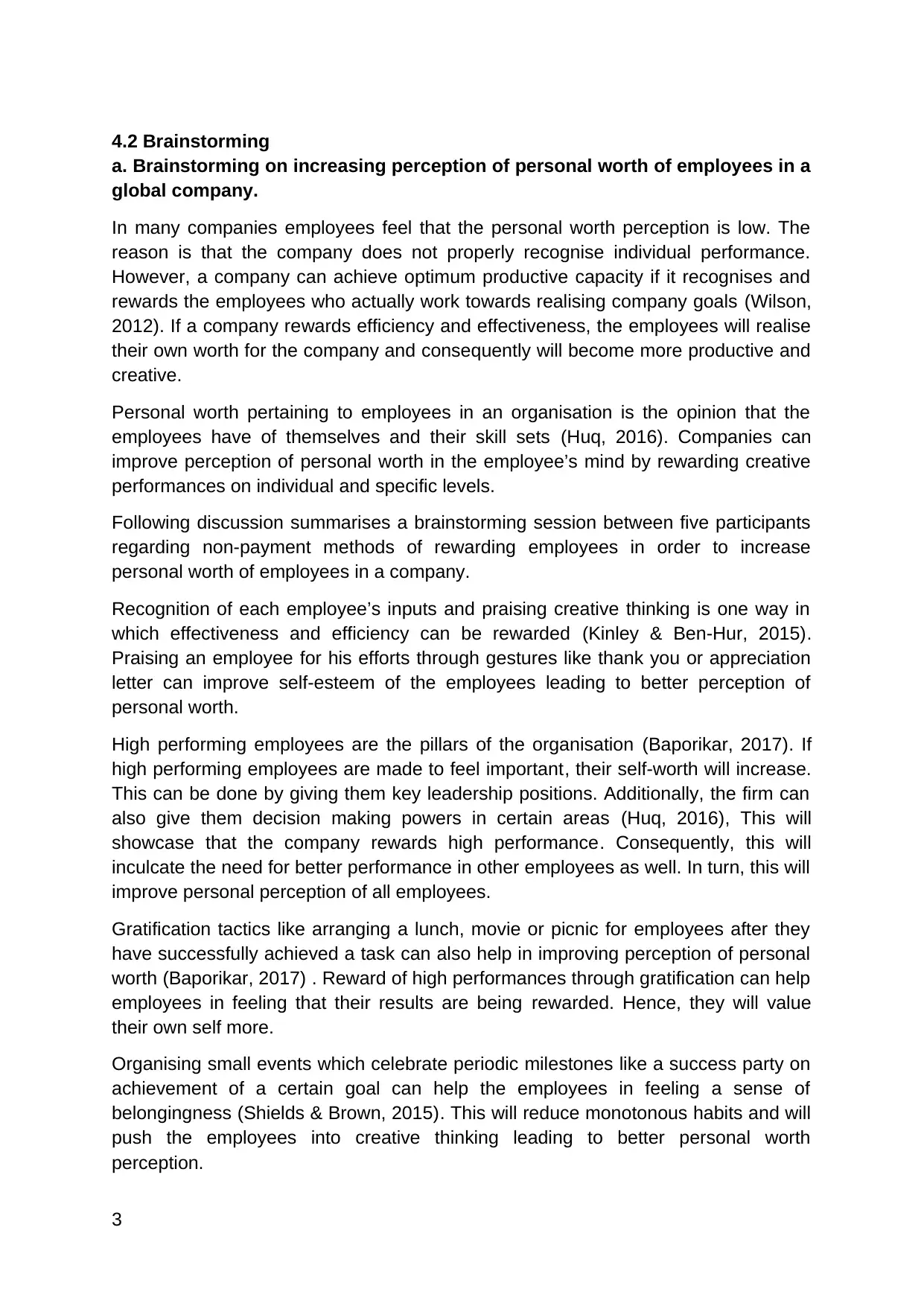
4.2 Brainstorming
a. Brainstorming on increasing perception of personal worth of employees in a
global company.
In many companies employees feel that the personal worth perception is low. The
reason is that the company does not properly recognise individual performance.
However, a company can achieve optimum productive capacity if it recognises and
rewards the employees who actually work towards realising company goals (Wilson,
2012). If a company rewards efficiency and effectiveness, the employees will realise
their own worth for the company and consequently will become more productive and
creative.
Personal worth pertaining to employees in an organisation is the opinion that the
employees have of themselves and their skill sets (Huq, 2016). Companies can
improve perception of personal worth in the employee’s mind by rewarding creative
performances on individual and specific levels.
Following discussion summarises a brainstorming session between five participants
regarding non-payment methods of rewarding employees in order to increase
personal worth of employees in a company.
Recognition of each employee’s inputs and praising creative thinking is one way in
which effectiveness and efficiency can be rewarded (Kinley & Ben-Hur, 2015).
Praising an employee for his efforts through gestures like thank you or appreciation
letter can improve self-esteem of the employees leading to better perception of
personal worth.
High performing employees are the pillars of the organisation (Baporikar, 2017). If
high performing employees are made to feel important, their self-worth will increase.
This can be done by giving them key leadership positions. Additionally, the firm can
also give them decision making powers in certain areas (Huq, 2016), This will
showcase that the company rewards high performance. Consequently, this will
inculcate the need for better performance in other employees as well. In turn, this will
improve personal perception of all employees.
Gratification tactics like arranging a lunch, movie or picnic for employees after they
have successfully achieved a task can also help in improving perception of personal
worth (Baporikar, 2017) . Reward of high performances through gratification can help
employees in feeling that their results are being rewarded. Hence, they will value
their own self more.
Organising small events which celebrate periodic milestones like a success party on
achievement of a certain goal can help the employees in feeling a sense of
belongingness (Shields & Brown, 2015). This will reduce monotonous habits and will
push the employees into creative thinking leading to better personal worth
perception.
3
a. Brainstorming on increasing perception of personal worth of employees in a
global company.
In many companies employees feel that the personal worth perception is low. The
reason is that the company does not properly recognise individual performance.
However, a company can achieve optimum productive capacity if it recognises and
rewards the employees who actually work towards realising company goals (Wilson,
2012). If a company rewards efficiency and effectiveness, the employees will realise
their own worth for the company and consequently will become more productive and
creative.
Personal worth pertaining to employees in an organisation is the opinion that the
employees have of themselves and their skill sets (Huq, 2016). Companies can
improve perception of personal worth in the employee’s mind by rewarding creative
performances on individual and specific levels.
Following discussion summarises a brainstorming session between five participants
regarding non-payment methods of rewarding employees in order to increase
personal worth of employees in a company.
Recognition of each employee’s inputs and praising creative thinking is one way in
which effectiveness and efficiency can be rewarded (Kinley & Ben-Hur, 2015).
Praising an employee for his efforts through gestures like thank you or appreciation
letter can improve self-esteem of the employees leading to better perception of
personal worth.
High performing employees are the pillars of the organisation (Baporikar, 2017). If
high performing employees are made to feel important, their self-worth will increase.
This can be done by giving them key leadership positions. Additionally, the firm can
also give them decision making powers in certain areas (Huq, 2016), This will
showcase that the company rewards high performance. Consequently, this will
inculcate the need for better performance in other employees as well. In turn, this will
improve personal perception of all employees.
Gratification tactics like arranging a lunch, movie or picnic for employees after they
have successfully achieved a task can also help in improving perception of personal
worth (Baporikar, 2017) . Reward of high performances through gratification can help
employees in feeling that their results are being rewarded. Hence, they will value
their own self more.
Organising small events which celebrate periodic milestones like a success party on
achievement of a certain goal can help the employees in feeling a sense of
belongingness (Shields & Brown, 2015). This will reduce monotonous habits and will
push the employees into creative thinking leading to better personal worth
perception.
3
⊘ This is a preview!⊘
Do you want full access?
Subscribe today to unlock all pages.

Trusted by 1+ million students worldwide
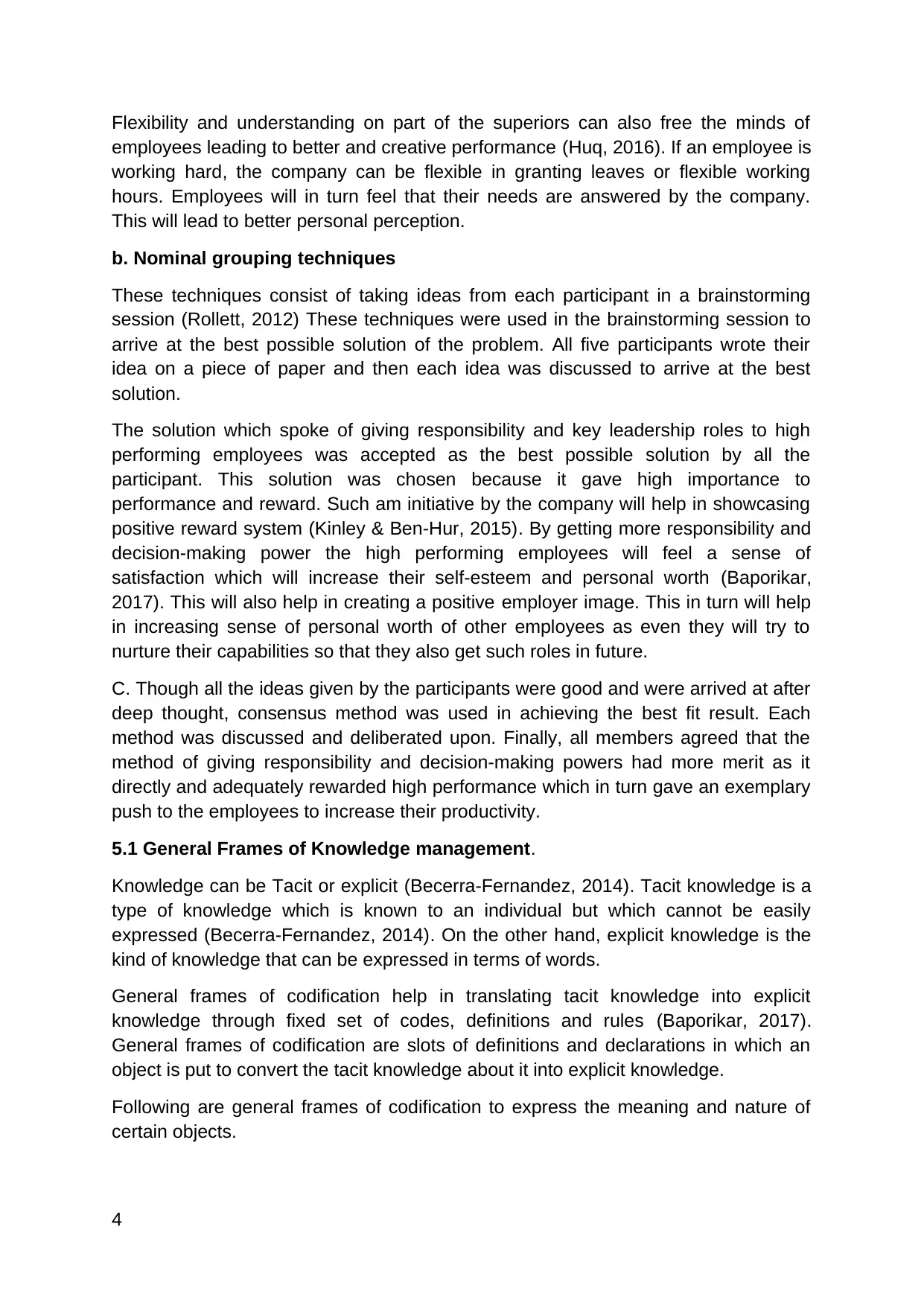
Flexibility and understanding on part of the superiors can also free the minds of
employees leading to better and creative performance (Huq, 2016). If an employee is
working hard, the company can be flexible in granting leaves or flexible working
hours. Employees will in turn feel that their needs are answered by the company.
This will lead to better personal perception.
b. Nominal grouping techniques
These techniques consist of taking ideas from each participant in a brainstorming
session (Rollett, 2012) These techniques were used in the brainstorming session to
arrive at the best possible solution of the problem. All five participants wrote their
idea on a piece of paper and then each idea was discussed to arrive at the best
solution.
The solution which spoke of giving responsibility and key leadership roles to high
performing employees was accepted as the best possible solution by all the
participant. This solution was chosen because it gave high importance to
performance and reward. Such am initiative by the company will help in showcasing
positive reward system (Kinley & Ben-Hur, 2015). By getting more responsibility and
decision-making power the high performing employees will feel a sense of
satisfaction which will increase their self-esteem and personal worth (Baporikar,
2017). This will also help in creating a positive employer image. This in turn will help
in increasing sense of personal worth of other employees as even they will try to
nurture their capabilities so that they also get such roles in future.
C. Though all the ideas given by the participants were good and were arrived at after
deep thought, consensus method was used in achieving the best fit result. Each
method was discussed and deliberated upon. Finally, all members agreed that the
method of giving responsibility and decision-making powers had more merit as it
directly and adequately rewarded high performance which in turn gave an exemplary
push to the employees to increase their productivity.
5.1 General Frames of Knowledge management.
Knowledge can be Tacit or explicit (Becerra-Fernandez, 2014). Tacit knowledge is a
type of knowledge which is known to an individual but which cannot be easily
expressed (Becerra-Fernandez, 2014). On the other hand, explicit knowledge is the
kind of knowledge that can be expressed in terms of words.
General frames of codification help in translating tacit knowledge into explicit
knowledge through fixed set of codes, definitions and rules (Baporikar, 2017).
General frames of codification are slots of definitions and declarations in which an
object is put to convert the tacit knowledge about it into explicit knowledge.
Following are general frames of codification to express the meaning and nature of
certain objects.
4
employees leading to better and creative performance (Huq, 2016). If an employee is
working hard, the company can be flexible in granting leaves or flexible working
hours. Employees will in turn feel that their needs are answered by the company.
This will lead to better personal perception.
b. Nominal grouping techniques
These techniques consist of taking ideas from each participant in a brainstorming
session (Rollett, 2012) These techniques were used in the brainstorming session to
arrive at the best possible solution of the problem. All five participants wrote their
idea on a piece of paper and then each idea was discussed to arrive at the best
solution.
The solution which spoke of giving responsibility and key leadership roles to high
performing employees was accepted as the best possible solution by all the
participant. This solution was chosen because it gave high importance to
performance and reward. Such am initiative by the company will help in showcasing
positive reward system (Kinley & Ben-Hur, 2015). By getting more responsibility and
decision-making power the high performing employees will feel a sense of
satisfaction which will increase their self-esteem and personal worth (Baporikar,
2017). This will also help in creating a positive employer image. This in turn will help
in increasing sense of personal worth of other employees as even they will try to
nurture their capabilities so that they also get such roles in future.
C. Though all the ideas given by the participants were good and were arrived at after
deep thought, consensus method was used in achieving the best fit result. Each
method was discussed and deliberated upon. Finally, all members agreed that the
method of giving responsibility and decision-making powers had more merit as it
directly and adequately rewarded high performance which in turn gave an exemplary
push to the employees to increase their productivity.
5.1 General Frames of Knowledge management.
Knowledge can be Tacit or explicit (Becerra-Fernandez, 2014). Tacit knowledge is a
type of knowledge which is known to an individual but which cannot be easily
expressed (Becerra-Fernandez, 2014). On the other hand, explicit knowledge is the
kind of knowledge that can be expressed in terms of words.
General frames of codification help in translating tacit knowledge into explicit
knowledge through fixed set of codes, definitions and rules (Baporikar, 2017).
General frames of codification are slots of definitions and declarations in which an
object is put to convert the tacit knowledge about it into explicit knowledge.
Following are general frames of codification to express the meaning and nature of
certain objects.
4
Paraphrase This Document
Need a fresh take? Get an instant paraphrase of this document with our AI Paraphraser
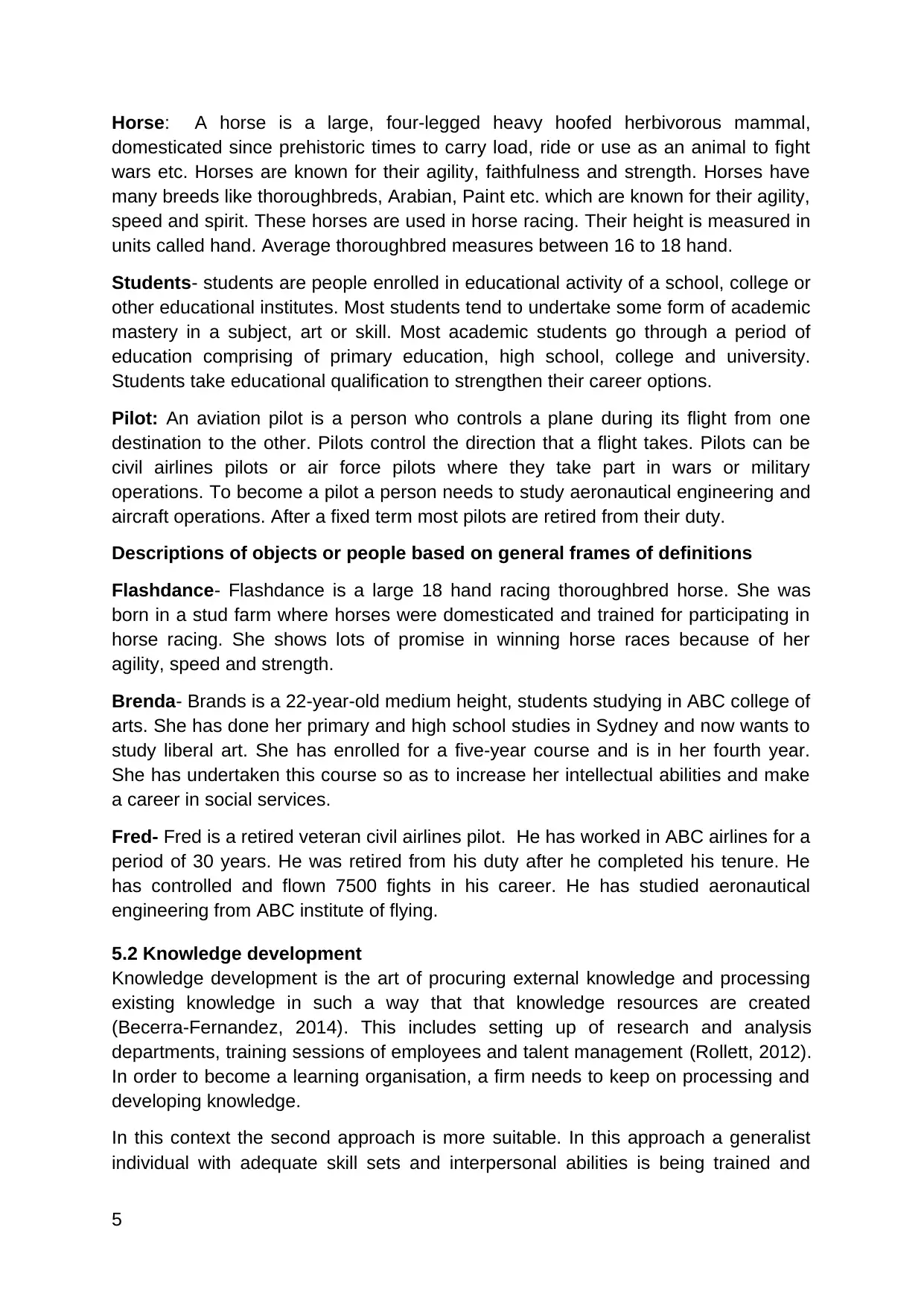
Horse: A horse is a large, four-legged heavy hoofed herbivorous mammal,
domesticated since prehistoric times to carry load, ride or use as an animal to fight
wars etc. Horses are known for their agility, faithfulness and strength. Horses have
many breeds like thoroughbreds, Arabian, Paint etc. which are known for their agility,
speed and spirit. These horses are used in horse racing. Their height is measured in
units called hand. Average thoroughbred measures between 16 to 18 hand.
Students- students are people enrolled in educational activity of a school, college or
other educational institutes. Most students tend to undertake some form of academic
mastery in a subject, art or skill. Most academic students go through a period of
education comprising of primary education, high school, college and university.
Students take educational qualification to strengthen their career options.
Pilot: An aviation pilot is a person who controls a plane during its flight from one
destination to the other. Pilots control the direction that a flight takes. Pilots can be
civil airlines pilots or air force pilots where they take part in wars or military
operations. To become a pilot a person needs to study aeronautical engineering and
aircraft operations. After a fixed term most pilots are retired from their duty.
Descriptions of objects or people based on general frames of definitions
Flashdance- Flashdance is a large 18 hand racing thoroughbred horse. She was
born in a stud farm where horses were domesticated and trained for participating in
horse racing. She shows lots of promise in winning horse races because of her
agility, speed and strength.
Brenda- Brands is a 22-year-old medium height, students studying in ABC college of
arts. She has done her primary and high school studies in Sydney and now wants to
study liberal art. She has enrolled for a five-year course and is in her fourth year.
She has undertaken this course so as to increase her intellectual abilities and make
a career in social services.
Fred- Fred is a retired veteran civil airlines pilot. He has worked in ABC airlines for a
period of 30 years. He was retired from his duty after he completed his tenure. He
has controlled and flown 7500 fights in his career. He has studied aeronautical
engineering from ABC institute of flying.
5.2 Knowledge development
Knowledge development is the art of procuring external knowledge and processing
existing knowledge in such a way that that knowledge resources are created
(Becerra-Fernandez, 2014). This includes setting up of research and analysis
departments, training sessions of employees and talent management (Rollett, 2012).
In order to become a learning organisation, a firm needs to keep on processing and
developing knowledge.
In this context the second approach is more suitable. In this approach a generalist
individual with adequate skill sets and interpersonal abilities is being trained and
5
domesticated since prehistoric times to carry load, ride or use as an animal to fight
wars etc. Horses are known for their agility, faithfulness and strength. Horses have
many breeds like thoroughbreds, Arabian, Paint etc. which are known for their agility,
speed and spirit. These horses are used in horse racing. Their height is measured in
units called hand. Average thoroughbred measures between 16 to 18 hand.
Students- students are people enrolled in educational activity of a school, college or
other educational institutes. Most students tend to undertake some form of academic
mastery in a subject, art or skill. Most academic students go through a period of
education comprising of primary education, high school, college and university.
Students take educational qualification to strengthen their career options.
Pilot: An aviation pilot is a person who controls a plane during its flight from one
destination to the other. Pilots control the direction that a flight takes. Pilots can be
civil airlines pilots or air force pilots where they take part in wars or military
operations. To become a pilot a person needs to study aeronautical engineering and
aircraft operations. After a fixed term most pilots are retired from their duty.
Descriptions of objects or people based on general frames of definitions
Flashdance- Flashdance is a large 18 hand racing thoroughbred horse. She was
born in a stud farm where horses were domesticated and trained for participating in
horse racing. She shows lots of promise in winning horse races because of her
agility, speed and strength.
Brenda- Brands is a 22-year-old medium height, students studying in ABC college of
arts. She has done her primary and high school studies in Sydney and now wants to
study liberal art. She has enrolled for a five-year course and is in her fourth year.
She has undertaken this course so as to increase her intellectual abilities and make
a career in social services.
Fred- Fred is a retired veteran civil airlines pilot. He has worked in ABC airlines for a
period of 30 years. He was retired from his duty after he completed his tenure. He
has controlled and flown 7500 fights in his career. He has studied aeronautical
engineering from ABC institute of flying.
5.2 Knowledge development
Knowledge development is the art of procuring external knowledge and processing
existing knowledge in such a way that that knowledge resources are created
(Becerra-Fernandez, 2014). This includes setting up of research and analysis
departments, training sessions of employees and talent management (Rollett, 2012).
In order to become a learning organisation, a firm needs to keep on processing and
developing knowledge.
In this context the second approach is more suitable. In this approach a generalist
individual with adequate skill sets and interpersonal abilities is being trained and
5
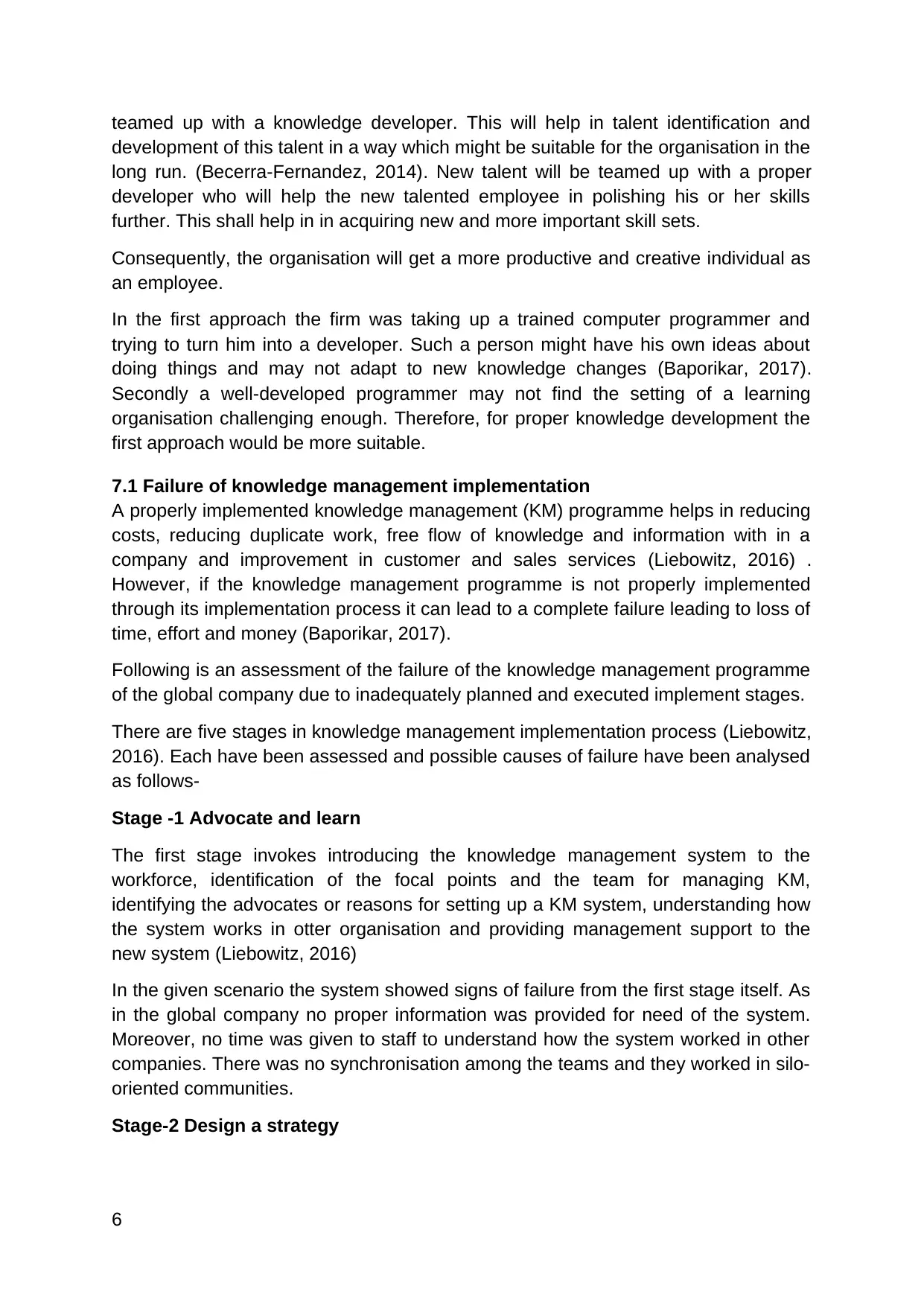
teamed up with a knowledge developer. This will help in talent identification and
development of this talent in a way which might be suitable for the organisation in the
long run. (Becerra-Fernandez, 2014). New talent will be teamed up with a proper
developer who will help the new talented employee in polishing his or her skills
further. This shall help in in acquiring new and more important skill sets.
Consequently, the organisation will get a more productive and creative individual as
an employee.
In the first approach the firm was taking up a trained computer programmer and
trying to turn him into a developer. Such a person might have his own ideas about
doing things and may not adapt to new knowledge changes (Baporikar, 2017).
Secondly a well-developed programmer may not find the setting of a learning
organisation challenging enough. Therefore, for proper knowledge development the
first approach would be more suitable.
7.1 Failure of knowledge management implementation
A properly implemented knowledge management (KM) programme helps in reducing
costs, reducing duplicate work, free flow of knowledge and information with in a
company and improvement in customer and sales services (Liebowitz, 2016) .
However, if the knowledge management programme is not properly implemented
through its implementation process it can lead to a complete failure leading to loss of
time, effort and money (Baporikar, 2017).
Following is an assessment of the failure of the knowledge management programme
of the global company due to inadequately planned and executed implement stages.
There are five stages in knowledge management implementation process (Liebowitz,
2016). Each have been assessed and possible causes of failure have been analysed
as follows-
Stage -1 Advocate and learn
The first stage invokes introducing the knowledge management system to the
workforce, identification of the focal points and the team for managing KM,
identifying the advocates or reasons for setting up a KM system, understanding how
the system works in otter organisation and providing management support to the
new system (Liebowitz, 2016)
In the given scenario the system showed signs of failure from the first stage itself. As
in the global company no proper information was provided for need of the system.
Moreover, no time was given to staff to understand how the system worked in other
companies. There was no synchronisation among the teams and they worked in silo-
oriented communities.
Stage-2 Design a strategy
6
development of this talent in a way which might be suitable for the organisation in the
long run. (Becerra-Fernandez, 2014). New talent will be teamed up with a proper
developer who will help the new talented employee in polishing his or her skills
further. This shall help in in acquiring new and more important skill sets.
Consequently, the organisation will get a more productive and creative individual as
an employee.
In the first approach the firm was taking up a trained computer programmer and
trying to turn him into a developer. Such a person might have his own ideas about
doing things and may not adapt to new knowledge changes (Baporikar, 2017).
Secondly a well-developed programmer may not find the setting of a learning
organisation challenging enough. Therefore, for proper knowledge development the
first approach would be more suitable.
7.1 Failure of knowledge management implementation
A properly implemented knowledge management (KM) programme helps in reducing
costs, reducing duplicate work, free flow of knowledge and information with in a
company and improvement in customer and sales services (Liebowitz, 2016) .
However, if the knowledge management programme is not properly implemented
through its implementation process it can lead to a complete failure leading to loss of
time, effort and money (Baporikar, 2017).
Following is an assessment of the failure of the knowledge management programme
of the global company due to inadequately planned and executed implement stages.
There are five stages in knowledge management implementation process (Liebowitz,
2016). Each have been assessed and possible causes of failure have been analysed
as follows-
Stage -1 Advocate and learn
The first stage invokes introducing the knowledge management system to the
workforce, identification of the focal points and the team for managing KM,
identifying the advocates or reasons for setting up a KM system, understanding how
the system works in otter organisation and providing management support to the
new system (Liebowitz, 2016)
In the given scenario the system showed signs of failure from the first stage itself. As
in the global company no proper information was provided for need of the system.
Moreover, no time was given to staff to understand how the system worked in other
companies. There was no synchronisation among the teams and they worked in silo-
oriented communities.
Stage-2 Design a strategy
6
⊘ This is a preview!⊘
Do you want full access?
Subscribe today to unlock all pages.

Trusted by 1+ million students worldwide
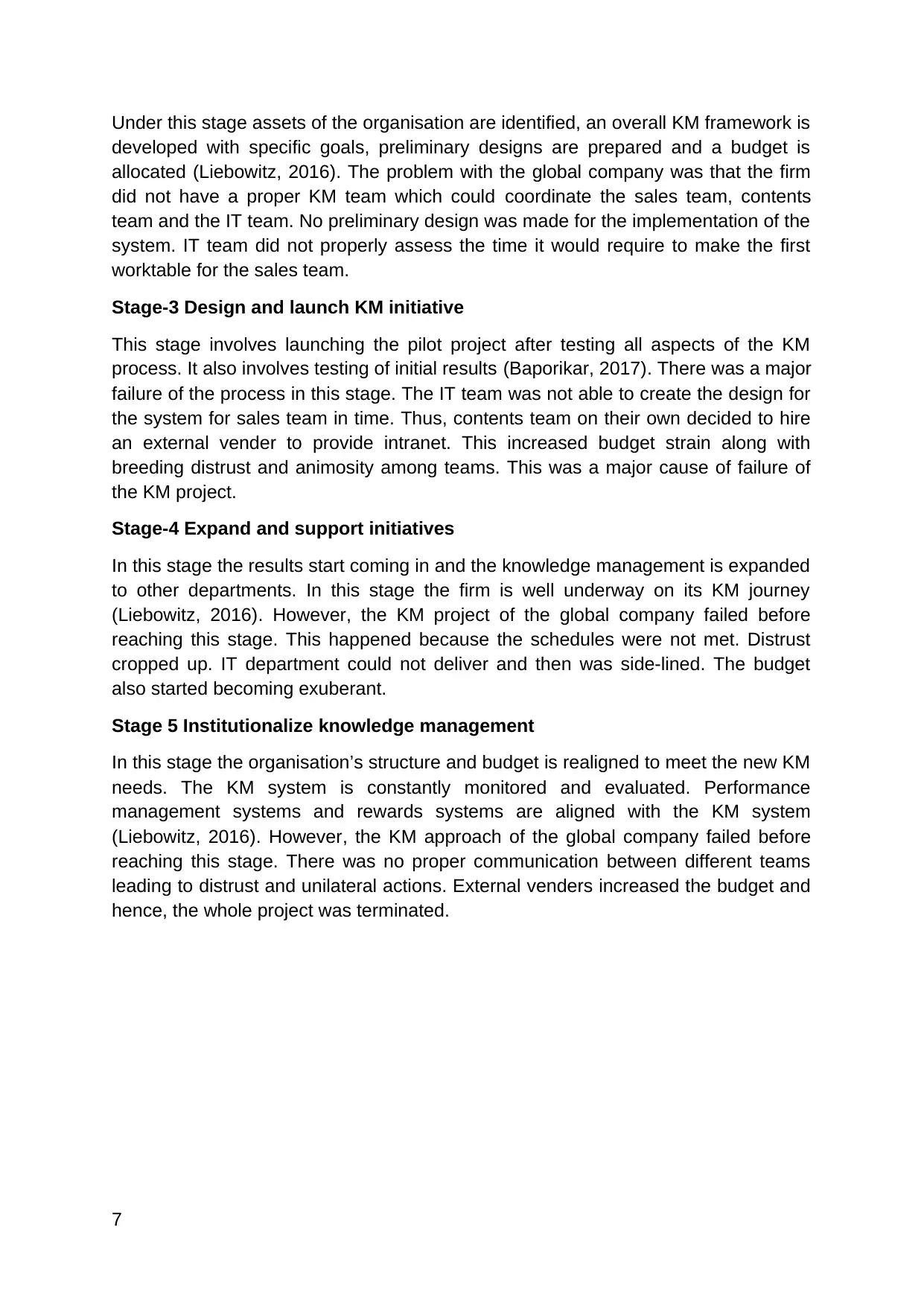
Under this stage assets of the organisation are identified, an overall KM framework is
developed with specific goals, preliminary designs are prepared and a budget is
allocated (Liebowitz, 2016). The problem with the global company was that the firm
did not have a proper KM team which could coordinate the sales team, contents
team and the IT team. No preliminary design was made for the implementation of the
system. IT team did not properly assess the time it would require to make the first
worktable for the sales team.
Stage-3 Design and launch KM initiative
This stage involves launching the pilot project after testing all aspects of the KM
process. It also involves testing of initial results (Baporikar, 2017). There was a major
failure of the process in this stage. The IT team was not able to create the design for
the system for sales team in time. Thus, contents team on their own decided to hire
an external vender to provide intranet. This increased budget strain along with
breeding distrust and animosity among teams. This was a major cause of failure of
the KM project.
Stage-4 Expand and support initiatives
In this stage the results start coming in and the knowledge management is expanded
to other departments. In this stage the firm is well underway on its KM journey
(Liebowitz, 2016). However, the KM project of the global company failed before
reaching this stage. This happened because the schedules were not met. Distrust
cropped up. IT department could not deliver and then was side-lined. The budget
also started becoming exuberant.
Stage 5 Institutionalize knowledge management
In this stage the organisation’s structure and budget is realigned to meet the new KM
needs. The KM system is constantly monitored and evaluated. Performance
management systems and rewards systems are aligned with the KM system
(Liebowitz, 2016). However, the KM approach of the global company failed before
reaching this stage. There was no proper communication between different teams
leading to distrust and unilateral actions. External venders increased the budget and
hence, the whole project was terminated.
7
developed with specific goals, preliminary designs are prepared and a budget is
allocated (Liebowitz, 2016). The problem with the global company was that the firm
did not have a proper KM team which could coordinate the sales team, contents
team and the IT team. No preliminary design was made for the implementation of the
system. IT team did not properly assess the time it would require to make the first
worktable for the sales team.
Stage-3 Design and launch KM initiative
This stage involves launching the pilot project after testing all aspects of the KM
process. It also involves testing of initial results (Baporikar, 2017). There was a major
failure of the process in this stage. The IT team was not able to create the design for
the system for sales team in time. Thus, contents team on their own decided to hire
an external vender to provide intranet. This increased budget strain along with
breeding distrust and animosity among teams. This was a major cause of failure of
the KM project.
Stage-4 Expand and support initiatives
In this stage the results start coming in and the knowledge management is expanded
to other departments. In this stage the firm is well underway on its KM journey
(Liebowitz, 2016). However, the KM project of the global company failed before
reaching this stage. This happened because the schedules were not met. Distrust
cropped up. IT department could not deliver and then was side-lined. The budget
also started becoming exuberant.
Stage 5 Institutionalize knowledge management
In this stage the organisation’s structure and budget is realigned to meet the new KM
needs. The KM system is constantly monitored and evaluated. Performance
management systems and rewards systems are aligned with the KM system
(Liebowitz, 2016). However, the KM approach of the global company failed before
reaching this stage. There was no proper communication between different teams
leading to distrust and unilateral actions. External venders increased the budget and
hence, the whole project was terminated.
7
Paraphrase This Document
Need a fresh take? Get an instant paraphrase of this document with our AI Paraphraser
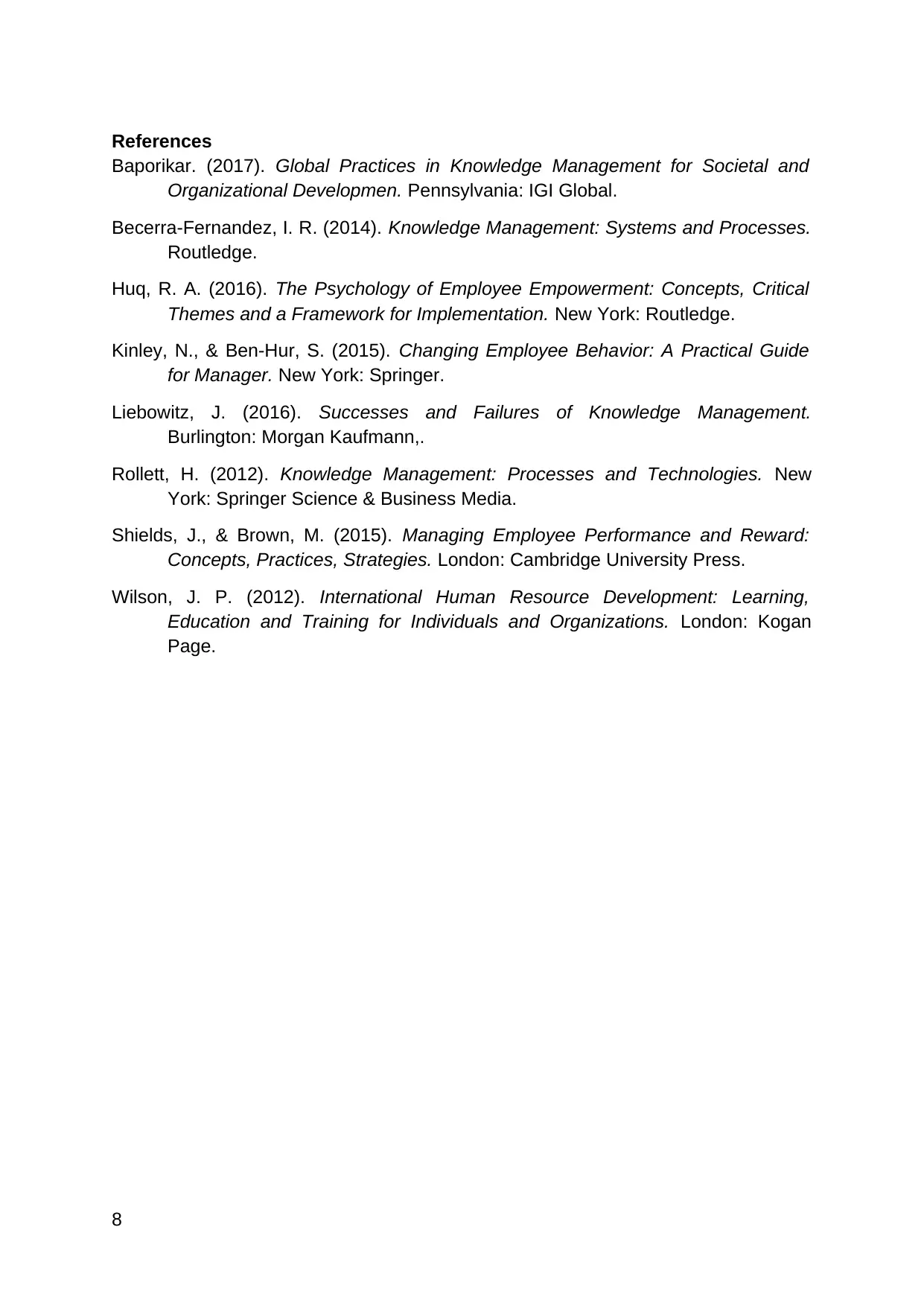
References
Baporikar. (2017). Global Practices in Knowledge Management for Societal and
Organizational Developmen. Pennsylvania: IGI Global.
Becerra-Fernandez, I. R. (2014). Knowledge Management: Systems and Processes.
Routledge.
Huq, R. A. (2016). The Psychology of Employee Empowerment: Concepts, Critical
Themes and a Framework for Implementation. New York: Routledge.
Kinley, N., & Ben-Hur, S. (2015). Changing Employee Behavior: A Practical Guide
for Manager. New York: Springer.
Liebowitz, J. (2016). Successes and Failures of Knowledge Management.
Burlington: Morgan Kaufmann,.
Rollett, H. (2012). Knowledge Management: Processes and Technologies. New
York: Springer Science & Business Media.
Shields, J., & Brown, M. (2015). Managing Employee Performance and Reward:
Concepts, Practices, Strategies. London: Cambridge University Press.
Wilson, J. P. (2012). International Human Resource Development: Learning,
Education and Training for Individuals and Organizations. London: Kogan
Page.
8
Baporikar. (2017). Global Practices in Knowledge Management for Societal and
Organizational Developmen. Pennsylvania: IGI Global.
Becerra-Fernandez, I. R. (2014). Knowledge Management: Systems and Processes.
Routledge.
Huq, R. A. (2016). The Psychology of Employee Empowerment: Concepts, Critical
Themes and a Framework for Implementation. New York: Routledge.
Kinley, N., & Ben-Hur, S. (2015). Changing Employee Behavior: A Practical Guide
for Manager. New York: Springer.
Liebowitz, J. (2016). Successes and Failures of Knowledge Management.
Burlington: Morgan Kaufmann,.
Rollett, H. (2012). Knowledge Management: Processes and Technologies. New
York: Springer Science & Business Media.
Shields, J., & Brown, M. (2015). Managing Employee Performance and Reward:
Concepts, Practices, Strategies. London: Cambridge University Press.
Wilson, J. P. (2012). International Human Resource Development: Learning,
Education and Training for Individuals and Organizations. London: Kogan
Page.
8
1 out of 8
Related Documents
Your All-in-One AI-Powered Toolkit for Academic Success.
+13062052269
info@desklib.com
Available 24*7 on WhatsApp / Email
![[object Object]](/_next/static/media/star-bottom.7253800d.svg)
Unlock your academic potential
Copyright © 2020–2025 A2Z Services. All Rights Reserved. Developed and managed by ZUCOL.



